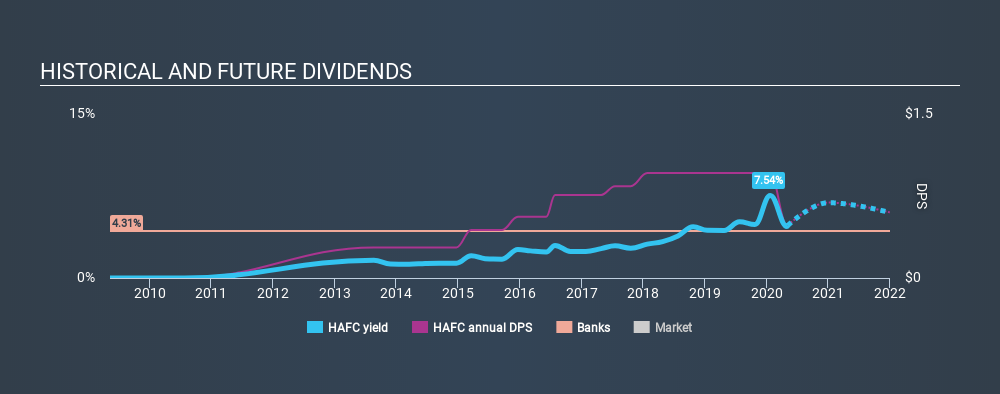- United States
- /
- Banks
- /
- NasdaqGS:HAFC
Why It Might Not Make Sense To Buy Hanmi Financial Corporation (NASDAQ:HAFC) For Its Upcoming Dividend

It looks like Hanmi Financial Corporation (NASDAQ:HAFC) is about to go ex-dividend in the next 2 days. If you purchase the stock on or after the 8th of May, you won't be eligible to receive this dividend, when it is paid on the 29th of May.
Hanmi Financial's next dividend payment will be US$0.12 per share, and in the last 12 months, the company paid a total of US$0.48 per share. Based on the last year's worth of payments, Hanmi Financial has a trailing yield of 4.8% on the current stock price of $10.02. If you buy this business for its dividend, you should have an idea of whether Hanmi Financial's dividend is reliable and sustainable. We need to see whether the dividend is covered by earnings and if it's growing.
Check out our latest analysis for Hanmi Financial
Dividends are usually paid out of company profits, so if a company pays out more than it earned then its dividend is usually at greater risk of being cut. Hanmi Financial distributed an unsustainably high 146% of its profit as dividends to shareholders last year. Without extenuating circumstances, we'd consider the dividend at risk of a cut.
Generally, the higher a company's payout ratio, the more the dividend is at risk of being reduced.
Click here to see the company's payout ratio, plus analyst estimates of its future dividends.

Have Earnings And Dividends Been Growing?
Companies with falling earnings are riskier for dividend shareholders. If earnings decline and the company is forced to cut its dividend, investors could watch the value of their investment go up in smoke. Hanmi Financial's earnings per share have fallen at approximately 16% a year over the previous five years. Ultimately, when earnings per share decline, the size of the pie from which dividends can be paid, shrinks.
The main way most investors will assess a company's dividend prospects is by checking the historical rate of dividend growth. In the past seven years, Hanmi Financial has increased its dividend at approximately 8.0% a year on average. That's intriguing, but the combination of growing dividends despite declining earnings can typically only be achieved by paying out a larger percentage of profits. Hanmi Financial is already paying out 146% of its profits, and with shrinking earnings we think it's unlikely that this dividend will grow quickly in the future.
To Sum It Up
Is Hanmi Financial an attractive dividend stock, or better left on the shelf? Not only are earnings per share shrinking, but Hanmi Financial is paying out a disconcertingly high percentage of its profit as dividends. It's not that we hate the business, but we feel that these characeristics are not desirable for investors seeking a reliable dividend stock to own for the long term. These characteristics don't generally lead to outstanding dividend performance, and investors may not be happy with the results of owning this stock for its dividend.
With that being said, if you're still considering Hanmi Financial as an investment, you'll find it beneficial to know what risks this stock is facing. For example, we've found 3 warning signs for Hanmi Financial that we recommend you consider before investing in the business.
A common investment mistake is buying the first interesting stock you see. Here you can find a list of promising dividend stocks with a greater than 2% yield and an upcoming dividend.
If you spot an error that warrants correction, please contact the editor at editorial-team@simplywallst.com. This article by Simply Wall St is general in nature. It does not constitute a recommendation to buy or sell any stock, and does not take account of your objectives, or your financial situation. Simply Wall St has no position in the stocks mentioned.
We aim to bring you long-term focused research analysis driven by fundamental data. Note that our analysis may not factor in the latest price-sensitive company announcements or qualitative material. Thank you for reading.
About NasdaqGS:HAFC
Hanmi Financial
Operates as the holding company for Hanmi Bank that provides business banking products and services in the United States.
Flawless balance sheet and good value.
Similar Companies
Market Insights
Community Narratives




